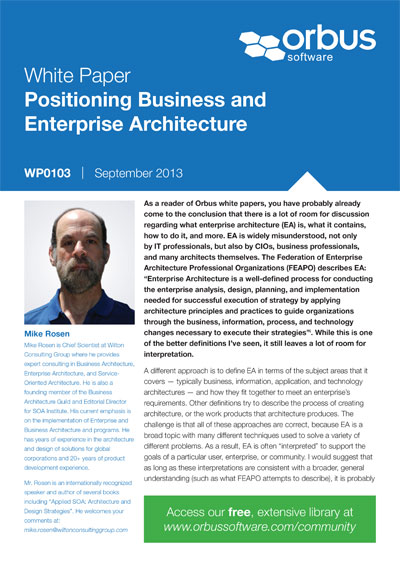In this paper, Mike Rosen takes the FEAPO’s description as a starting point and interprets different definitions of Enterprise Architecture to better understand the broad nature of the topic.
As a reader of Orbus white papers, you have probably already come to the conclusion that there is a lot of room for discussion regarding what enterprise architecture (EA) is, what it contains, how to do it, and more. EA is widely misunderstood, not only by IT professionals, but also by CIOs, business professionals, and many architects themselves. The Federation of Enterprise Architecture Professional Organizations (FEAPO) describes EA: “Enterprise Architecture is a well-defined process for conducting the enterprise analysis, design, planning, and implementation needed for successful execution of strategy by applying architecture principles and practices to guide organizations through the business, information, process, and technology changes necessary to execute their strategies”i . While this is one of the better definitions I’ve seen, it still leaves a lot of room from interpretation.
A different approach is to define EA in terms of the subject areas that it covers — typically business, information, application, and technology architectures — and how they fit together to meet an enterprise’s requirements. Other definitions try to describe the process of creating architecture, or the work products that architecture produces. The challenge is that all of these approaches are correct, because EA is a broad topic with many different techniques used to solve a variety of different problems. As a result, EA is often “interpreted” to support the goals of a particular user, enterprise, or community. I would suggest that as long as these interpretations are consistent with a broader, general understanding (such as what FEAPO attempts to describe), it is probably an effective strategy to focus EA on meeting your particular goals, with the understanding that it is one of many such interpretations.
Please login to continue reading, or sign up to download this white paper.
